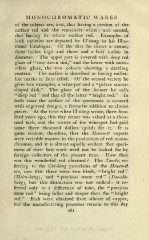Page 347 - Oriental Series Japan and China, Brinkly
P. 347
MONOCHROMATIC WARES
of the subject are, first, that having a portion of the
surface red and the remainder white and second,
;
that having its whole surface red. Examples of
both varieties are depicted by H'siang in his Illus-
trated Catalogue. Of the first he shows a censer,
three inches high and three and a half inches in
diameter. The upper part is covered with deep red
glaze of " rosy dawn tint," and the lower with snow-
white glaze, the two colours showing a dazzling
contrast. The surface is described as having millet-
like marks in faint relief. Of the second variety he
gives two examples, a wine-pot and a " palace saucer-
shaped dish." The glaze of the former he calls
" of the latter "
" and that bright red." In
deep red
both cases the surface of the specimens is covered
with engraved designs, a favourite addition to choice
pieces. At the time when H'siang wrote, three hun-
dred years ago, this tiny censer was valued at a thou-
sand taels, and the owner of the wine-pot had paid
some three thousand dollars (gold) for it. It is
quite evident, therefore, that the Hsuan-te experts
were veritable masters in the production of red mono-
chromes, and it is almost equally evident that speci-
mens of their best work need not be looked for by
Howforeign collectors of the present time.
then
was this wonderful red obtained ? The Tao-lu re-
t
ferring to the Chi-hung porcelains of the Hsuan-f?
era, says that
there were two kinds, " "
bright red
(Hsien-hung\, and "precious stone red" (Pao-shi-
hung}, but this distinction was not radical: it re-
"
ferred only to a difference of tone, the precious
" being fuller and deeper than the " bright
stone red
red." Both were obtained from silicate of copper,
but the manufacturing processes remain to this day
281

